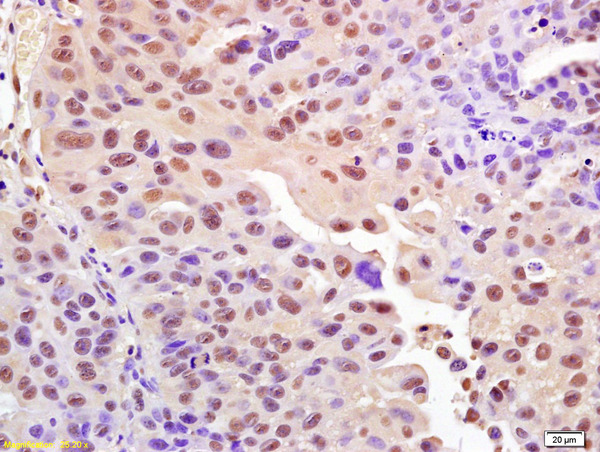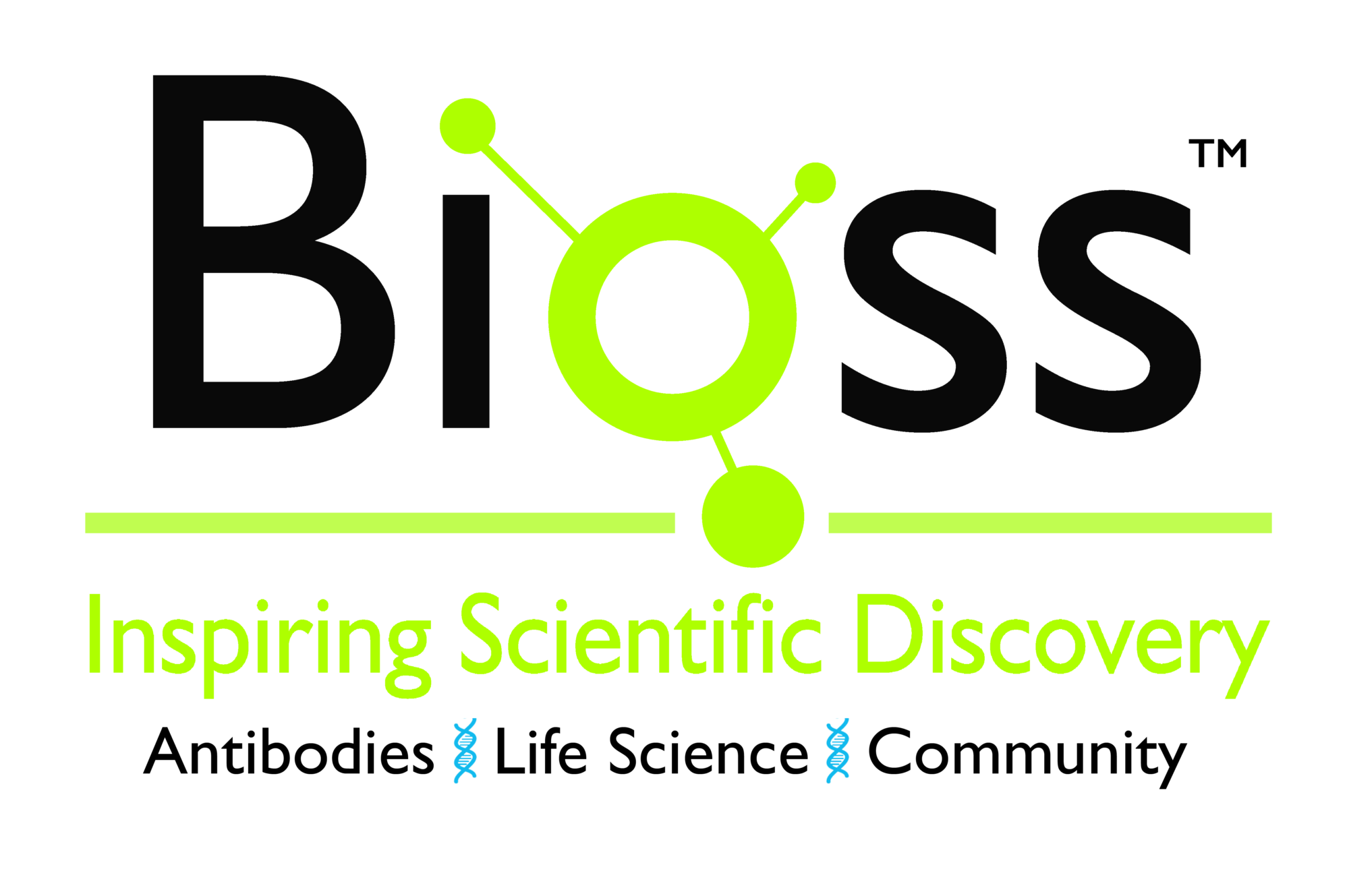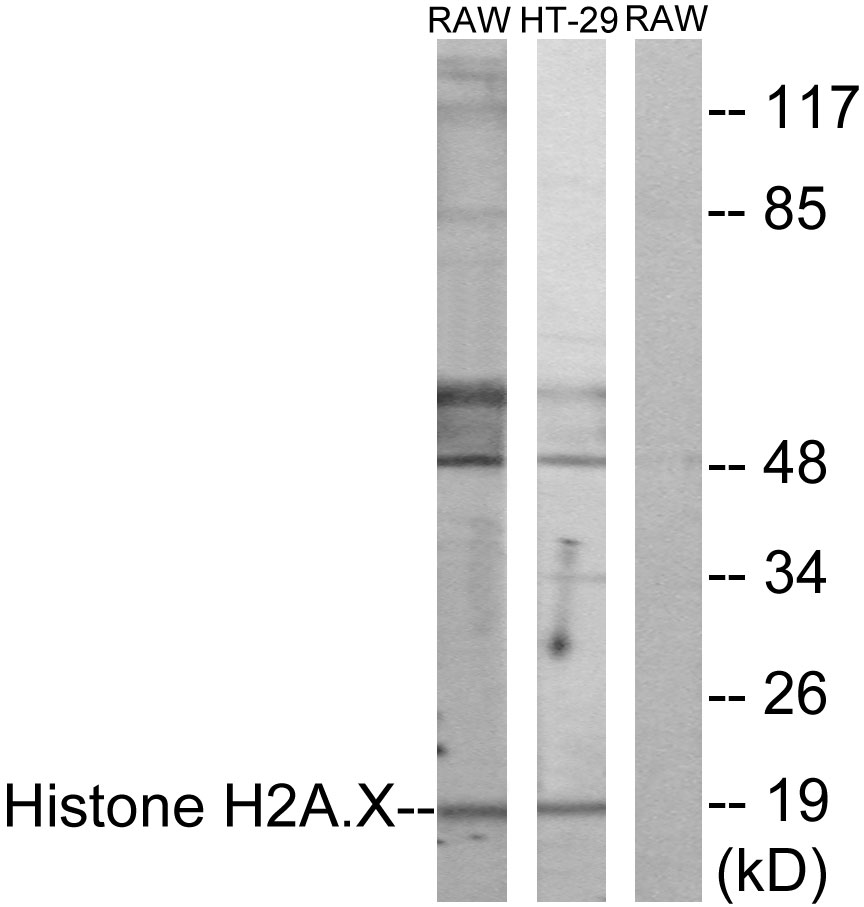![IHC-P analysis of postnatal mouse (PN19) lung sections using GTX80694 Histone H2A.XS139ph (phospho Ser139) antibody [3F2]. Increased staining intensity was observed in a genetic mouse model with DNA damage in airway cells. Antigen retrieval : heat induced epitope retrieval (HIER) method with sodium citrate buffer (pH 6.0) Fixation : 4% Paraformaldehyde Dilution : 1:400 IHC-P analysis of postnatal mouse (PN19) lung sections using GTX80694 Histone H2A.XS139ph (phospho Ser139) antibody [3F2]. Increased staining intensity was observed in a genetic mouse model with DNA damage in airway cells. Antigen retrieval : heat induced epitope retrieval (HIER) method with sodium citrate buffer (pH 6.0) Fixation : 4% Paraformaldehyde Dilution : 1:400](https://www.genetex.com/upload/website/prouct_img/normal/GTX80694/GTX80694_1409_IHC-P_w_23061322_374.webp)
IHC-P analysis of postnatal mouse (PN19) lung sections using GTX80694 Histone H2A.XS139ph (phospho Ser139) antibody [3F2]. Increased staining intensity was observed in a genetic mouse model with DNA damage in airway cells. Antigen retrieval : heat induced epitope retrieval (HIER) method with sodium citrate buffer (pH 6.0) Fixation : 4% Paraformaldehyde Dilution : 1:400
Histone H2A.XS139ph (phospho Ser139) antibody [3F2]
GTX80694
ApplicationsFlow Cytometry, ImmunoFluorescence, Western Blot, ELISA, ImmunoCytoChemistry, ImmunoHistoChemistry, ImmunoHistoChemistry Paraffin
Product group Antibodies
TargetH2AX
Overview
- SupplierGeneTex
- Product NameHistone H2A.XS139ph (phospho Ser139) antibody [3F2]
- Delivery Days Customer9
- Application Supplier NoteWB: 1 microg/ml. ICC/IF: 2-4 microg/ml. IHC-P: 1:400. FACS: 1microg per 106 cells. *Optimal dilutions/concentrations should be determined by the researcher.Not tested in other applications.
- ApplicationsFlow Cytometry, ImmunoFluorescence, Western Blot, ELISA, ImmunoCytoChemistry, ImmunoHistoChemistry, ImmunoHistoChemistry Paraffin
- CertificationResearch Use Only
- ClonalityMonoclonal
- Clone ID3F2
- Concentration1 mg/ml
- ConjugateUnconjugated
- Gene ID3014
- Target nameH2AX
- Target descriptionH2A.X variant histone
- Target synonymsH2A.X, H2A/X, H2AFX, histone H2AX, H2A histone family member X, H2AX histone, histone H2A.x
- HostMouse
- IsotypeIgG1
- Protein IDP16104
- Protein NameHistone H2AX
- Scientific DescriptionHistones are basic nuclear proteins that are responsible for the nucleosome structure of the chromosomal fiber in eukaryotes. Two molecules of each of the four core histones (H2A, H2B, H3, and H4) form an octamer, around which approximately 146 bp of DNA is wrapped in repeating units, called nucleosomes. The linker histone, H1, interacts with linker DNA between nucleosomes and functions in the compaction of chromatin into higher order structures. This gene encodes a replication-independent histone that is a member of the histone H2A family, and generates two transcripts through the use of the conserved stem-loop termination motif, and the polyA addition motif. [provided by RefSeq, Oct 2015]
- Storage Instruction-20°C or -80°C,2°C to 8°C
- UNSPSC12352203
References
- Wang YY, Chen YK, Hu SC, et al. CYT-Rx20 inhibits ovarian cancer cells in vitro and in vivo through oxidative stress-induced DNA damage and cell apoptosis. Cancer Chemother Pharmacol. 2017,79(6):1129-1140. doi: 10.1007/s00280-017-3330-9Read this paper
- Wang YY, Chen YK, Hsu YL, et al. Synthetic β-nitrostyrene derivative CYT-Rx20 as inhibitor of oral cancer cell proliferation and tumor growth through glutathione suppression and reactive oxygen species induction. Head Neck. 2017,39(6):1055-1064. doi: 10.1002/hed.24664Read this paper
- Shang HS, Chang CH, Chou YR, et al. Curcumin causes DNA damage and affects associated protein expression in HeLa human cervical cancer cells. Oncol Rep. 2016,36(4):2207-15. doi: 10.3892/or.2016.5002Read this paper
- Lee JH, Guo Z, Myler LR, et al. Direct activation of ATM by resveratrol under oxidizing conditions. PLoS One. 2014,9(6):e97969. doi: 10.1371/journal.pone.0097969Read this paper
- Smith S, Fox J, Mejia M, et al. Histone deacetylase inhibitors selectively target homology dependent DNA repair defective cells and elevate non-homologous endjoining activity. PLoS One. 2014,9(1):e87203. doi: 10.1371/journal.pone.0087203Read this paper
- Fox JT, Sakamuru S, Huang R, et al. High-throughput genotoxicity assay identifies antioxidants as inducers of DNA damage response and cell death. Proc Natl Acad Sci U S A. 2012,109(14):5423-8. doi: 10.1073/pnas.1114278109Read this paper
- Kinjo T, Ham-Terhune J, Peloponese JM Jr, et al. Induction of reactive oxygen species by human T-cell leukemia virus type 1 tax correlates with DNA damage and expression of cellular senescence marker. J Virol. 2010,84(10):5431-7. doi: 10.1128/JVI.02460-09Read this paper

![WB analysis of Jurkat cell untreated (Lane 1) and Jurkat cell stimulated with staurosporine (Lane 2) using GTX80694 Histone H2A.XS139ph (phospho Ser139) antibody [3F2]. Dilution : 1 microg/ml WB analysis of Jurkat cell untreated (Lane 1) and Jurkat cell stimulated with staurosporine (Lane 2) using GTX80694 Histone H2A.XS139ph (phospho Ser139) antibody [3F2]. Dilution : 1 microg/ml](https://www.genetex.com/upload/website/prouct_img/normal/GTX80694/GTX80694_1953_WB_w_23061322_801.webp)
![ICC/IF analysis of cells using GTX80694 Histone H2A.XS139ph (phospho Ser139) antibody [3F2]. ICC/IF analysis of cells using GTX80694 Histone H2A.XS139ph (phospho Ser139) antibody [3F2].](https://www.genetex.com/upload/website/prouct_img/normal/GTX80694/GTX80694_2034_ICC-IF_w_23061322_855.webp)
![ICC/IF analysis of gamma irradiated HeLa cells using GTX80694 Histone H2A.XS139ph (phospho Ser139) antibody [3F2]. ICC/IF analysis of gamma irradiated HeLa cells using GTX80694 Histone H2A.XS139ph (phospho Ser139) antibody [3F2].](https://www.genetex.com/upload/website/prouct_img/normal/GTX80694/GTX80694_898_ICC-IF_w_23061322_522.webp)
![ICC/IF analysis of A549 cells treated with vehicle (control; 0.1% DMSO in media) or with 50 microM etoposide for 1 hour using GTX80694 Histone H2A.XS139ph (phospho Ser139) antibody [3F2]. Red : Primary antibody Blue : Nuclei ICC/IF analysis of A549 cells treated with vehicle (control; 0.1% DMSO in media) or with 50 microM etoposide for 1 hour using GTX80694 Histone H2A.XS139ph (phospho Ser139) antibody [3F2]. Red : Primary antibody Blue : Nuclei](https://www.genetex.com/upload/website/prouct_img/normal/GTX80694/GTX80694_899_ICC-IF_w_23061322_993.webp)





